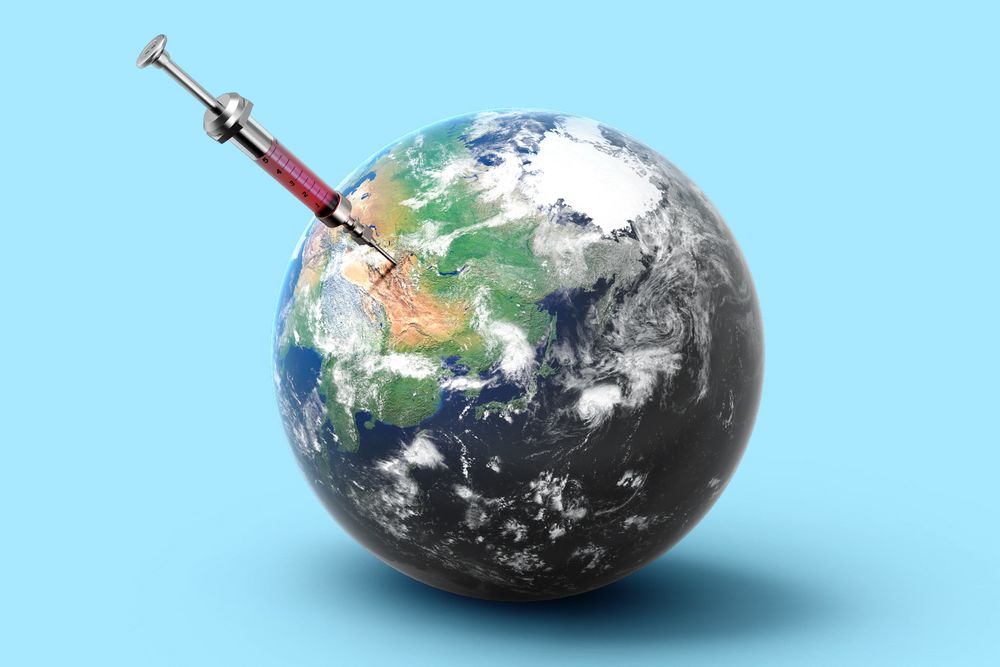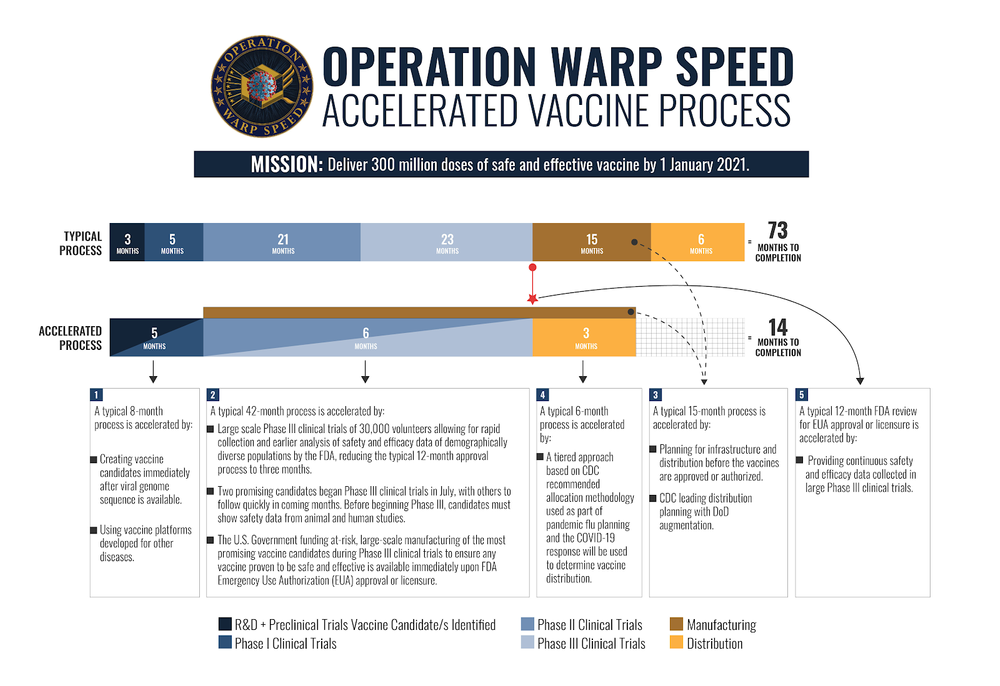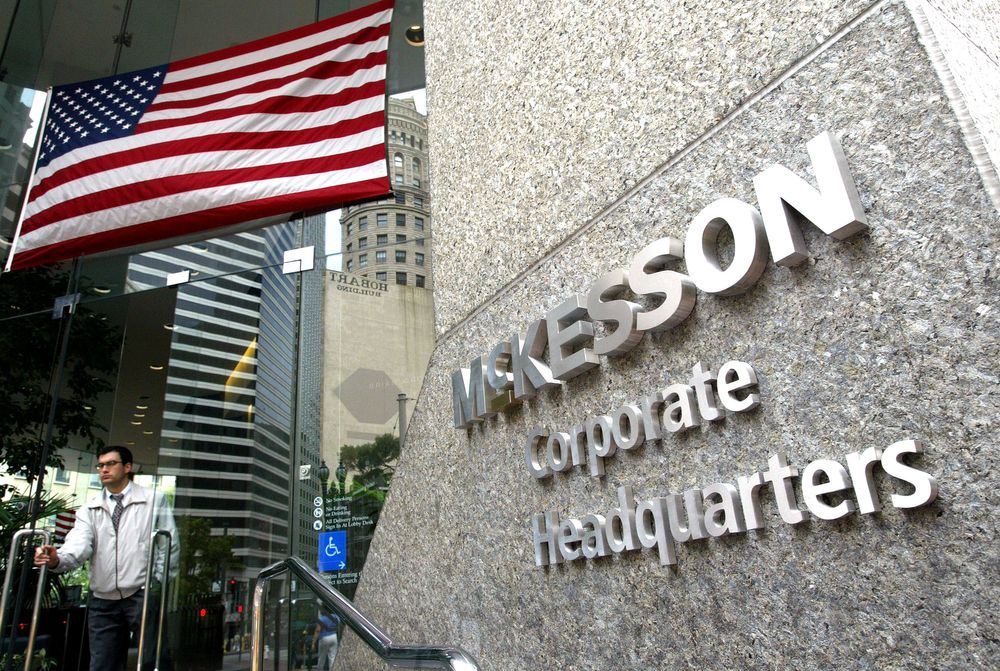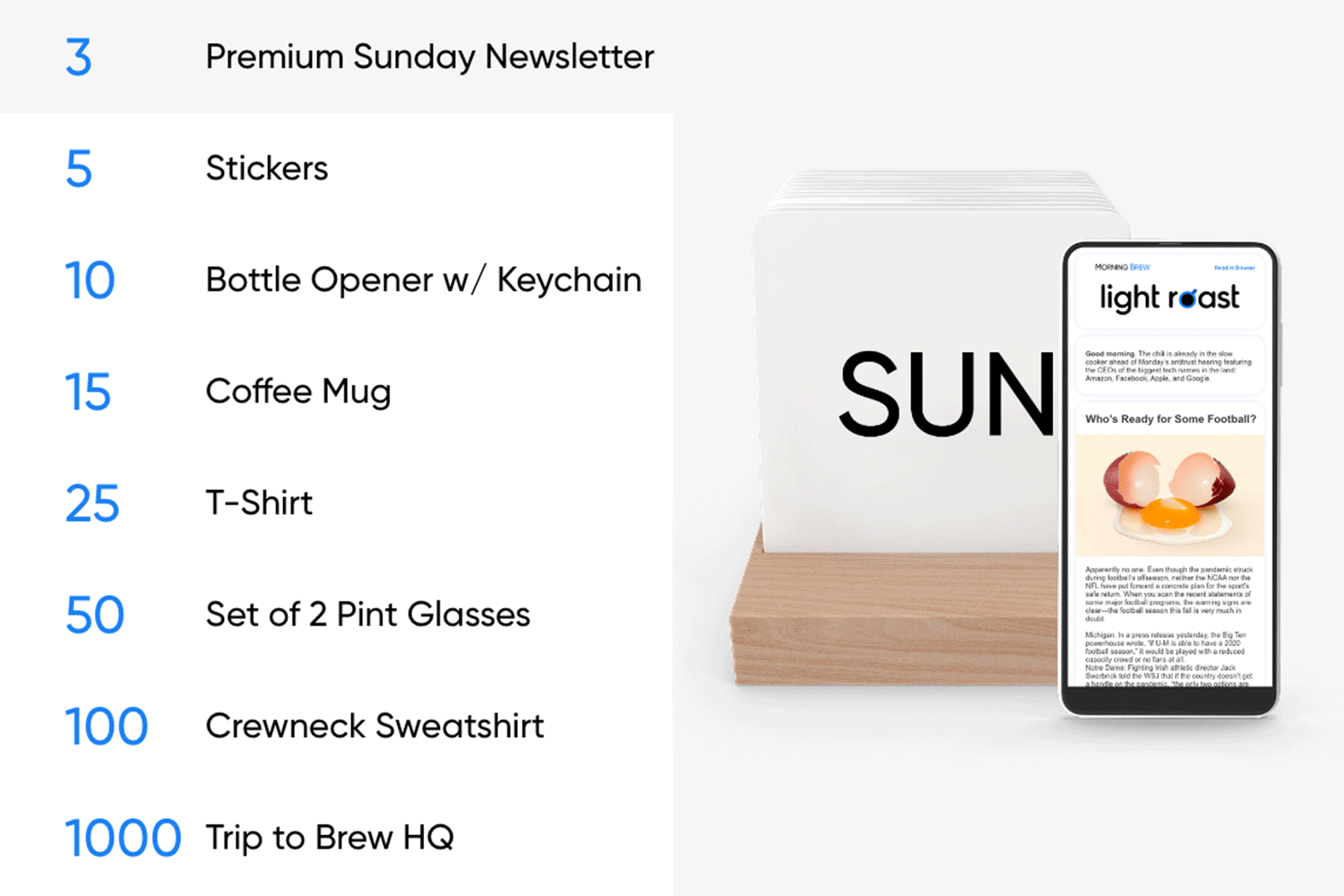| Good morning and Happy Belated Thanksgiving. Since you're probably taking a break from your day-to-day routine, so are we. Which means that today and tomorrow, we're excited to present special reports on one of the greatest challenges of our time: The incredibly complex and incredibly fascinating Covid-19 vaccine supply chain. - Day 1 (today) will break down the material logistics of vaccines: How they're made, how they're distributed, who's doing the distributing, etc.
- On Day 2 (tomorrow), we'll focus on the human element: Who will get a vaccine? And how many people even want one?
P.S.: This newsletter is best enjoyed with leftovers. | |  Francis Scialabba | Maybe Thanksgiving is getting us sentimental, but the concept of a vaccine is kind of...amazing? Someone injects a distorted version of a virus into you and then your body learns how to defend against it. It's not not magical. Here's how those painful miracles of science come to be The process that generates the lifesaving poky boys is grounded in cold, hard science and logistics. But, it's mind-numbingly complicated; think Christopher Nolan film plus Gillian Flynn novel times your flightiest friend's romantic status. From a business POV, it's also extremely risky. Regulators license the process behind making a vaccine in addition to the biological product itself. That means that any major tweaks to that process trigger another round of tire-kicking. As a result, the failure rate in vaccine manufacturing is high and supply often runs short. - Plus, it's not cheap. The total costs of vaccine development can run up to $500 million, one study found.
Methodologies vary, but the overall breakdown goes something like this: Step 1: Create an antigen (a substance that provokes your immune system). Scientists do this by literally growing it in a cell—like the basil plant on your window, but tiny. Step 2: Take the baby antigen out of the cell where it was grown. Basil's gotta become pesto at some point. Step 3: Next, the antigen is purified through processes that sound like words you'd make up when lying about doing science homework: chromatography and ultrafiltration. Step 4 (optional): In some cases, some extra spices are added to strengthen the antigen, or to add shelf life. Step 5: Distribution—mix up all the components in vials or syringes, load those suckers on trucks, and get them in some arms. Vaccine manufacturing is Isla de Muerta It's an island that cannot be found, except by those who already know where it is. The field is dominated by legacy players, because only those with significant existing scale can foot the bill for the necessary raw material, facilities, regulatory compliance, and labor. - Did you know there's currently a shortage of sand needed to make glass vials for vaccine storage? Or that one ingredient used in vaccines comes from the bark of the Quillaja saponaria Molina tree in South America that's only harvested two months of the year? Probably not, but Pfizer does.
Zoom out: The companies currently vying to get a Covid-19 vaccine to market are pursuing different biological methods, in the hopes that a "throw everything against the wall" approach will lead to a few sticking. | |  U.S. Dept. of Defense | ...but it's pretty dang fast. After the Manhattan Project and training dolphins to locate sea mines, Operation Warp Speed (OWS) could go down as one of the most successful government initiatives in recent memory. So what is it exactly? The goal: To deliver 300 million doses of a safe and effective vaccine by Jan. 2021. It was created as a sort of "project manager" to coordinate all the moving parts between government agencies and private companies. Budget: Up to $18 billion. More than $12 billion has already been doled out in vaccine-related contracts. Why it matters: As you can see in the graphic above, OWS is trying to squeeze what's typically a 73-month process into just 14 months. So far, it appears to be working. Looking ahead...OWS leadership has said they can deliver a Covid-19 vaccine to every state less than 24 hours after FDA approval. | |  | SimpliSafe are the security masterminds who give you 24/7 whole-home protection. It's like if your guard dog was part cyborg and connected to Skynet—except in this scenario Skynet is good and not a horrible world-ending supercomputer. What we're saying is, it's pretty much the best security system you can get your hands on. And since the shopping powers-that-be have decided today is Super Shopping Day—we feel like there's a term for this already?—SimpliSafe is having their best sale of the year. You'll get 50% off your SimpliSafe system that protects you from break-ins, emergencies, fires, and more PLUS a free HD security camera. U.S. News & World Report even named SimpliSafe the "Best Overall Home Security of 2020," which is pretty cool as far as bragging rights go. Secure your 50% off and free HD camera from Simplisafe right here. | |  Giphy | Leading vaccine candidates are more temperature-sensitive than your dad who doesn't let anyone touch the thermostat. - To avoid spoiling, Pfizer-BioNTech's vaccine must be transported and stored at -94°F, while Moderna's prefers a balmier -4°F.
Maintaining these below-freezing temps puts enormous strain on distribution. Here's what goes into the "cold chain:" - Airlines deliver doses in temperature-controlled holds. This could be the biggest bottleneck in the supply chain, given that one-in-four passenger airplanes (which actually ship the majority of air freight) has been grounded during the pandemic. Expect cargo companies to pick up the slack.
- Storage is tight. UPS and Lufthansa have been scrambling to build massive "freezer farms" near airports to receive vaccines. Drug companies will also make use of existing cold storage facilities, but according to a JLL report, 78% of U.S. cold storage warehouses are at least 20 years old and don't meet modern standards.
- Dry ice is the cold chain's best friend. Pfizer has designed temperature-controlled dry ice boxes that can maintain a roughly -94° Fahrenheit temperature for up to 10 days. Each box can hold about 5,000 doses.
Bottom line: Even with distributors and drug companies beefing up their cold chain capacity, pharma experts still expect a spoilage rate between 5% and 20%. | | | Here's a look at some of the stats that illustrate one of the largest logistical challenges in human history. Vaccine candidates - 67 vaccine candidates are currently in various stages of clinical trials around the world.
- 10 billion single doses could be available by the end of 2022 if all the frontrunner vaccine candidates are approved.
Purchase agreements - Five—the number of individual doses the U.K. has pre-bought for each citizen, which is the highest per-capita amount in the world.
- $21—the difference in price between Moderna's vaccine ($25/dose) and AstraZeneca's vaccine ($4/dose), according to U.S. purchase agreements.
Sourcing - 850 million syringes will be required for Covid-19 vaccine delivery in the U.S.
- 2% of the required amount of anticipated needles and syringes in the U.S. are located in the Strategic National Stockpile, the country's repository of critical medical supplies.
Distribution - 8,000 fully filled 747 cargo planes would be needed to distribute a single vaccine dose to the world's 7.8 billion people, per the International Air Transportation Association.
- 15,000 total cargo flights would be required to vaccinate the entire planet, according to a DHL study.
| |  Justin Sullivan/Getty Images | While a global pandemic has put many companies in "unprecedented situations," for others, like McKesson, it's given them an opportunity to step up. McKesson, based out of Irving, TX, is the country's largest drug distributor. It handles the behind-the-scenes logistics of getting drugs and medical supplies—from flu shots to generics—to the places that need them: pharmacies, hospitals, and more. - It's a lucrative business. With revenues of $231 billion last fiscal year, it ranked eighth on the Fortune 500 list...just ahead of AT&T.
Put me in, coach Through Operation Warp Speed, the government has made McKesson the central distributor of Covid-19 vaccines (outside of Pfizer-BioNTech's, which needs to live in sub-Arctic temps). - The company will not make decisions on where to send the vaccines, however. That's up to local and state officials.
Because of McKesson's expertise in schlepping life-saving material, the country has tapped it for similar programs before. In 2009, the U.S. government hired the company to distribute H1N1 vaccines (which was then the largest public health project in the CDC's history). Zoom out: McKesson's playing Superman now, but it's also been accused of participating in one of the darkest episodes of the U.S. pharmaceutical industry's history. Along with two rival distributors, McKesson said they could collectively pay up to $21 billion to resolve lawsuits alleging they fueled the opioid crisis. | |  Giphy | We just spit a lot of information at you about the vaccine supply chain. To tie everything together, let's explore the hypothetical journey of a single dose of a Moderna coronavirus vaccine from manufacturing → arm. Our quest begins in the quaint New England town of Portsmouth, NH, where about 100 workers at Lonza Biologics are busy concocting Moderna's vaccine. - Lonza signed a contract with Moderna in July to make the vaccine in small batches, and now it's ramping up production in anticipation of emergency use authorization.
Where to next? The vaccine will fly in those Elsa-approved containers to a McKesson distribution facility in Irving, TX. There, they'll be paired up with goody bags full of needles, syringes, and alcohol swabs in a process known as "kitting." Then, they're on the road, this time to a regional distribution center. This could just be a local hospital, because the main requirement is enough freezer space to keep the vaccine cold. And now, the final leg. The vaccine will head to an administration site like a mobile clinic or a Costco, where injectees will get a shot, a chicken bake, six gallons of salsa, and be on their way. But not so fast: Moderna's vaccine requires two doses 28 days apart. So hurry up on that salsa. | | | Good-for-you coffee, great-for-you sale. Four Sigmatic coffee is made with Lion's Mane and Chaga mushrooms to help with productivity and immune support. And now you can get up to 50% off all their bestsellers—but only until Nov 30. Save on shroom coffee here.* Butt wait. Still using TP to clean your rear? TUSHY's powerful stream of fresh water washes away all the booty BS of 2020. H2Omg! TUSHY bidet easily attaches to any toilet in under 10 minutes. Get 15% off all weekend long for Black BROWN FRIDAY!* House party: The Digital Mirage Friendsgiving festival starts this morning with livestreamed performances from Benny Benassi, The Glitch Mob, and more. Follow Friday: Take a detour from Black Friday shopping to read the funniest reviews on Amazon products via this subReddit. Our favorites include... *This is sponsored advertising content | | | A kangaroo word contains another word (a joey) within themselves. A joey word is a synonym of the kangaroo word, and the letters must be in the same order. Example: "rapscallion" contains the word "rascal": RApSCALlion See if you can find the joey words in these kangaroo words: - exists
- deceased
- barren
- precipitation
- prematurely
- feasted (there are two joey words in here)
| | | When you share the Brew, you earn rewards. From Brew swag like t-shirts and coffee mugs to exclusive content, we've got something for everyone in our premier rewards program.  Hit the button below to start sharing the Brew. Click to ShareOr copy & paste your referral link to others:
morningbrew.com/daily/r/?kid=8386977e | | | 1. is (exISts)
2. dead (DEceAseD)
3. bare (BARrEn)
4. rain (pRecipitAtIoN)
5. early (prEmAtuReLY)
6. fed / ate (FEasteD / feAsTEd) Source | | |
No comments:
Post a Comment